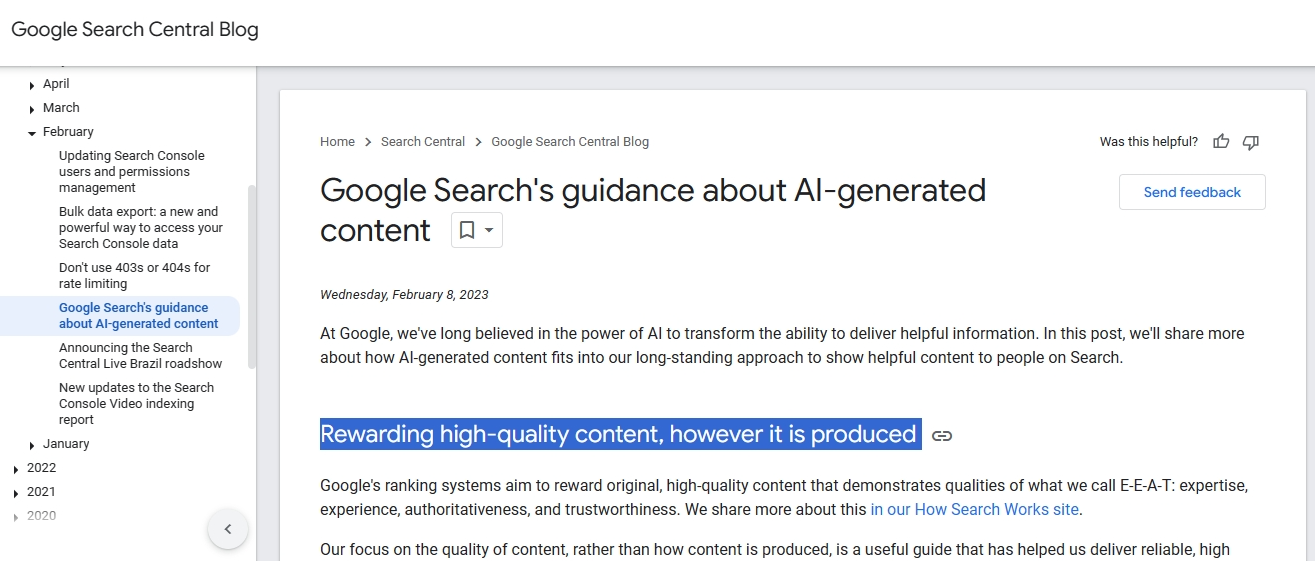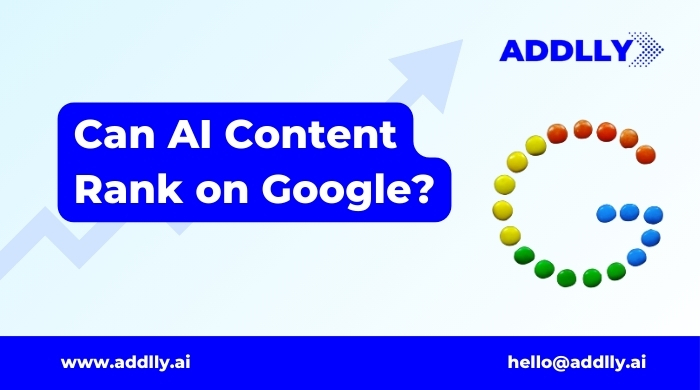AI content is everywhere, but can AI content rank on Google and compete with human-created articles? The short answer is yes, if done right. Businesses are using AI-generated content to save time while meeting the quality standards search engines expect. This blog post breaks down proven methods to make AI content rank by combining technology with human creativity.
You’ll learn how to create content that matches search intent, attracts organic traffic, and stays compliant with Google’s guidelines. Let’s explore the steps to help your AI content stand out and climb search rankings.
Does AI Content Really Stand a Chance?
Yes, AI content can rank on Google when it meets the same standards as high quality content from human writers. Recent studies show AI-generated content can appear in top search rankings if it is relevant, well-structured, and optimized for search intent.
Search engines focus on content quality, not just who or what created it. AI Agents and tools like Addlly’s AI Writer can speed up the content creation process, but human creativity, editing, and fact-checking are key for success.
When these elements combine, AI content can earn more organic traffic, engage your target audience, and hold strong positions in competitive search results.
What Google Says About AI-Generated Content?

According to Google Search Central Blog, Google has confirmed that it does not penalize AI-generated content simply for being produced by artificial intelligence. The focus is on delivering helpful content that meets its quality standards and aligns with the Helpful Content System. If AI content is accurate, relevant, and created with the user intent in mind, it can rank on Google alongside human generated content.
Google’s guidelines stress the importance of E-E-A-T, experience, expertise, authoritativeness, and trustworthiness. Whether you use AI tools or human writers, your goal should be to produce content that offers genuine value and answers search queries effectively.
Why Some AI Content Fails?
Not all AI content rank efforts succeed. While AI tools can speed up creating content, certain mistakes can keep it from performing well in search engine rankings. Here are the main reasons AI-generated content often falls short:
- Lack of originality: Copying existing data or over-relying on generic outputs leads to low quality content that adds no unique value.
- Ignoring search intent: Content that doesn’t match what users are looking for will struggle to appear in relevant search results.
- No human editing: Skipping the final editing process leaves errors, awkward phrasing, or factual mistakes that reduce credibility.
- Over-automation: Publishing without human input makes it harder to build trust and authority with your target audience.
- Weak E-E-A-T signals: Missing author bios, citations, or credible sources can prevent content from earning trust from search engines.
SEO Best Practices to Humanize & Rank AI Content
1. Mix AI Efficiency with Human Creativity
AI tools can quickly generate articles, outlines, and ideas, but they cannot fully replace the human touch. Combining AI-generated content with human creativity ensures your work feels authentic and engaging. While AI can structure and draft, human writers add storytelling, emotional connection, and context that machines often miss.
This mix helps maintain content quality and relevance for your target audience.
2. Optimize for Search Intent, Not Just Keywords
Focusing only on keywords can lead to content that ranks poorly because it fails to match what users actually want. Search intent is the reason behind a search query, and AI-generated content should address it directly.
Before writing, identify if the intent is informational, navigational, or transactional. Then, do a proper keyword research and shape the article to provide a complete answer.
3. Improve Readability with Short Sentences and Clear Formatting
AI-generated content often needs refining to make it easier for readers to follow. Short sentences and clear formatting improve readability and keep users engaged. Break text into small paragraphs and use subheadings to guide the reader through the topic.
Include bullet points or numbered lists for complex points. This structure not only helps readers but also makes it easier for search engines to understand the content. Readable AI content has a better chance to rank on Google.
4. Strengthen E-E-A-T with Author Bios and Credible Sources
Google values E-E-A-T, experience, expertise, authoritativeness, and trustworthiness, when ranking AI-generated content. Adding a short author bio with relevant credentials builds trust with readers and signals credibility to search engines.
Citing credible sources, such as studies, official reports, or respected publications, adds authority to your work.
5. Use Structured Data and Rich Snippets for Higher Click-Through
Structured data helps search engines understand AI-generated content better and present it attractively in search results. Adding schema markup for articles, FAQs, or reviews can enable rich snippets, which stand out and increase click-through rate.
AI tools can assist in generating the content, but human editing ensures that the markup is accurate and compliant with Google’s guidelines. This combination improves visibility, makes the listing more engaging, and can help AI content rank higher while attracting more targeted visitors.
6. Enhance Engagement with Multimedia and Internal Linking
Multimedia elements like images, videos, and infographics make AI-generated content more engaging and keep readers on the page longer. Visuals help explain concepts faster and appeal to different learning styles. Internal linking guides users to related articles, improving site navigation and increasing topical relevance in the eyes of search engines.
AI tools can suggest linking opportunities, but human review ensures they are contextually appropriate. This approach supports better user signals, such as lower bounce rates and longer session times, which can help AI content rank higher and perform better in organic traffic results.
7. Refresh and Update Content to Stay Algorithm-Friendly
Search engines favor content that stays current and relevant. AI-generated content should be reviewed regularly to ensure it reflects the latest facts, statistics, and trends. Updating headings, meta descriptions, and examples keeps the material fresh for both readers and search engine algorithms. This process also provides a chance to add new internal links or expand sections based on updated search intent.
AI tools can help identify outdated sections, but human editing ensures accuracy and quality. Regular updates improve the chances for AI content to rank on Google and maintain its position in competitive search results.
8. Avoid Over-Automation to Maintain Authenticity and Trust
Relying too much on AI tools can lead to generic, low quality content that lacks personality. Readers and search engines value authenticity, which comes from adding human creativity and unique insights. Over-automation often results in repetitive phrases, vague points, or content that fails to meet user intent.
While AI can speed up the content creation process, human editing is necessary to ensure clarity, originality, and accuracy.
Balancing automation with human input helps AI content rank on Google, builds trust with your target audience, and delivers a reading experience that feels genuine and valuable.
9. Add Original Research and Case Studies
Original research and case studies make AI-generated content more credible and unique. By including fresh data, surveys, or real-life examples, you provide value that competitors may not offer. This type of content shows expertise and supports E-E-A-T, helping your pages stand out in search engine rankings.
AI tools can assist in structuring and presenting the information, but human input ensures accuracy and context. These elements make your AI content rank better and keep readers engaged.
AEO + GEO Tactics to Get Cited in AI Overviews & Generative Search
1. Write Direct Answers
AI search engines and Google’s AI Overviews prefer concise, clear responses at the start of a section. When creating AI-generated content, include a short, direct answer, ideally within the first 60 words, that addresses the search query completely.
This format makes it easier for search engines to extract your response for featured snippets or AI summaries.
Direct answers improve visibility, satisfy user intent quickly, and increase the chances of your content being featured in both traditional and AI search results.
2. Use Proper FAQ and HowTo Schema
Schema markup helps search engines understand your AI-generated content and present it in enhanced formats. Adding FAQ schema allows your answers to appear directly in Google’s results, while HowTo schema can guide users step-by-step.
This structured data increases click-through rate and makes your content more appealing in AI Overviews. AI tools can generate draft schema, but human editing ensures it is accurate and meets Google’s guidelines.
Including schema also signals topical relevance, which is a big part of a better search engine optimization strategy.
3. Structure Content with Question Based Headings
Using question-based headings helps both search engines and AI systems quickly identify what your content is about. When AI-generated content includes headings that match common search queries, it becomes easier for algorithms to feature it in AI Overviews or answer boxes.
For example, headings like “Does Google Penalize AI-Generated Content?” align with user intent and improve topical relevance. This approach also makes the article more engaging for readers, as it feels like you’re anticipating their questions.
4. Maintain Content Freshness
AI Overviews and search engines prioritize content that is current and accurate. Regularly reviewing AI-generated content ensures it reflects the latest information, trends, and statistics. This can include updating examples, replacing outdated data, and refining meta descriptions to align with new search intent.
AI tools can help identify sections that may need updates, but human editing is essential for accuracy and context. Fresh content signals to search engine algorithms that your page is actively maintained, which can boost rankings.
How Addlly AI Can Help You Rank Better on Google?
Addlly AI builds powerful custom AI agents to boost your SEO and GEO results. With our SEO AI Agent, you can generate optimized content that aligns with search intent and E-E-A-T standards. Our GEO AI Agent ensures your content appears in AI Overviews and other AI search engines. Plus, the GEO Audit Tool analyzes your site’s performance in AI generated responses and tools, highlighting opportunities for improvement.
Key benefits include:
- Automated, high-quality AI content creation
- SEO and GEO optimization in one workflow
- Actionable audits for better rankings
Addlly AI helps you rank on Google faster while attracting the right audience.
Final Words
AI-generated content can rank on Google when it combines the efficiency of AI tools with the precision of human editing. By focusing on search intent, E-E-A-T, and user-friendly formatting, you can create helpful content that earns higher search rankings.
Addlly’s SEO AI Agent, GEO AI Agent, and GEO Audit Tool make this process easier by automating optimization and ensuring your content meets both SEO and GEO requirements.
Whether you want to improve visibility in AI Overviews or reach more local users, the right blend of AI and strategy can deliver consistent, measurable results for your brand.
FAQs – Can AI Content Rank
Does Google Penalize AI-Generated Content?
No, Google does not penalize AI-generated content just because it is created by AI. What matters is the quality, accuracy, and value of the content. If your content follows Google’s guidelines, matches search intent, and provides helpful information, it can rank alongside content written by humans.
Can AI Content Rank In Google’s AI Overviews and Chatgpt Answers?
Yes, AI content can appear in Google’s AI Overviews and ChatGPT answers if it is well-structured, accurate, and optimized. Using clear headings, direct answers, and schema markup improves the chances of your content being cited by AI systems in both search results and conversational responses.
What Are The Biggest Mistakes To Avoid With AI Content?
The biggest mistakes include publishing AI content without human editing, ignoring search intent, and using generic or low quality information. Avoid over-automation and always check for accuracy, originality, and relevance. Adding human creativity and credible sources helps your AI content perform better and rank higher on Google.

